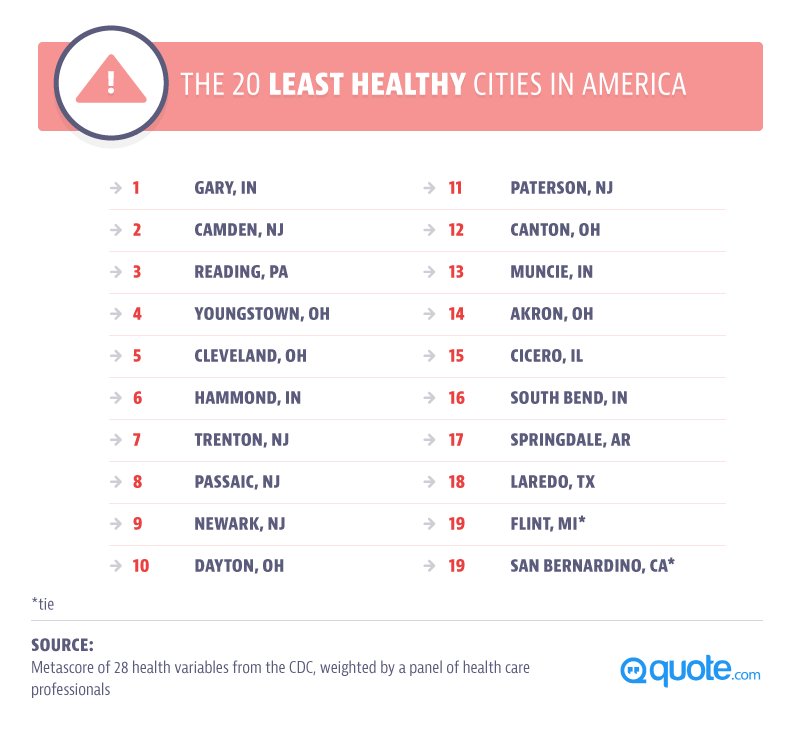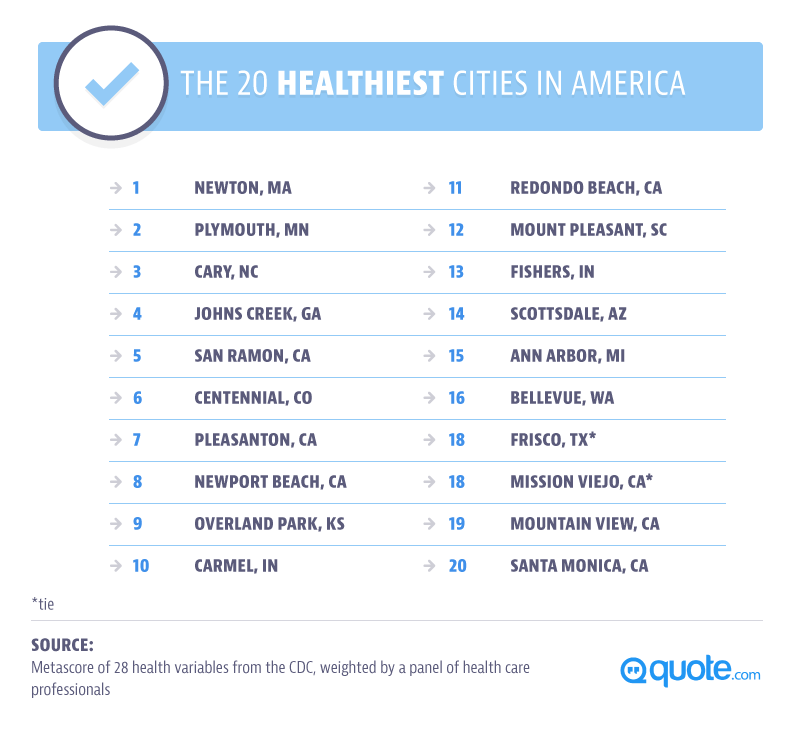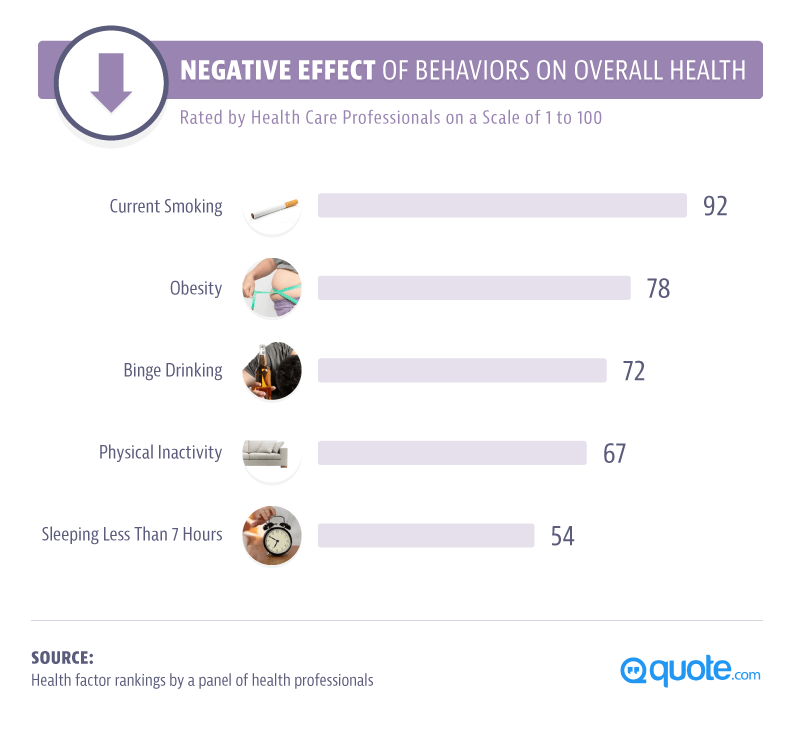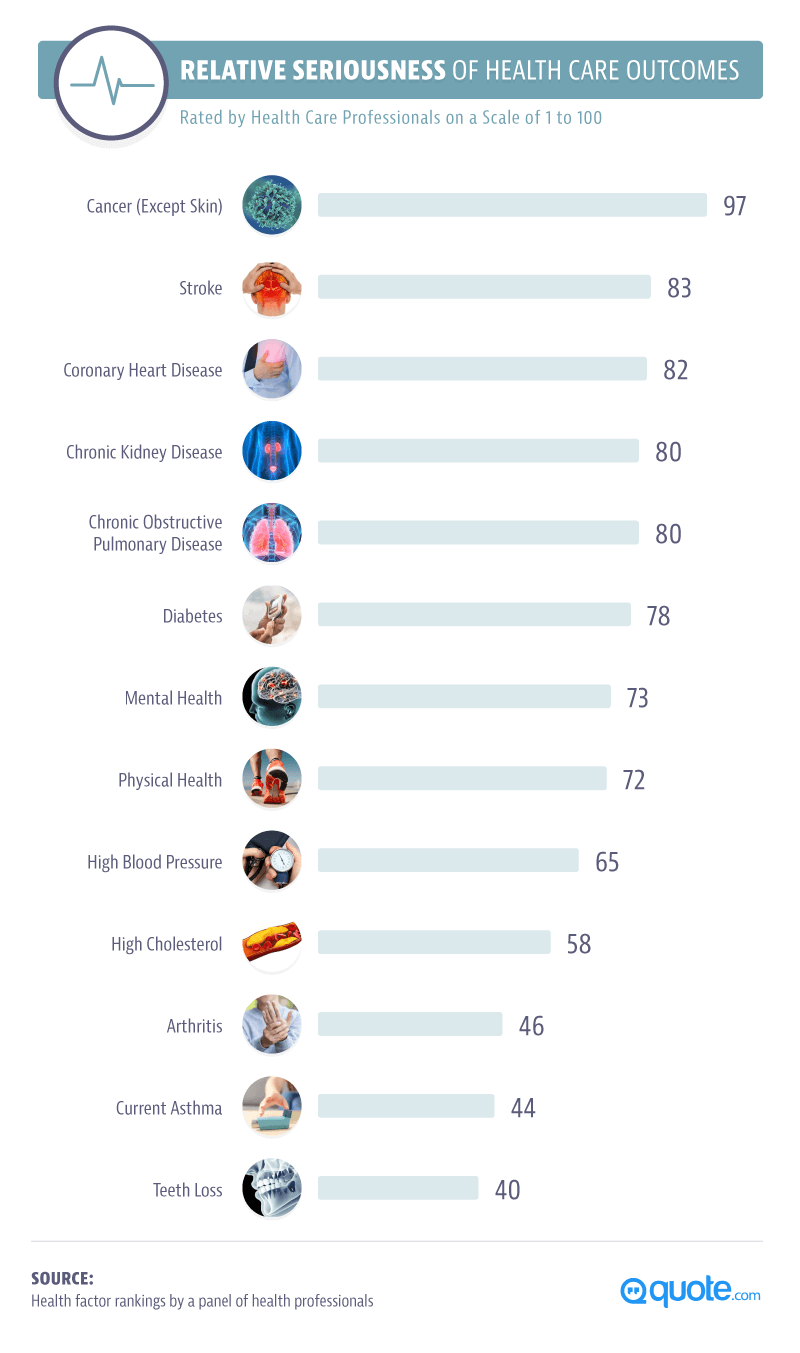Experts say good health is a major contributor to overall happiness. And it's safe to say that most of us strive to live happy, healthy, and long lives.
But can the area in which you live determine just how healthy or happy you can be? Several studies have concluded geographic location, down to the neighborhood we're raised and reside in, plays a key role in our physical health.
Instead of guessing which factors determine "healthiness" in specific areas, we brought in 12 medical experts to hone in on the most critical health metrics, utilizing data from the CDC and Robert Wood Johnson Foundation's 500 Cities Project.
These seasoned care providers with backgrounds in several fields of medicine ranked critical negative issues such as obesity, heart disease, cancer, and diabetes, as well as positive preventive behaviors like regular mammograms, cancer screenings, and health insurance coverage to find a hierarchy that our panel agreed were most important in determining overall health.
We then applied their 28 weighted factors to data from 500 locales across the nation to find the healthiest and unhealthiest areas in America.
Unhealthiest Cities in America
The least healthy city in the U.S. was Gary, Indiana, just 30 miles from Chicago. Unfortunately, Gary has been battling its share of economic problems over the years.
Still fighting a high crime rate, 20 percent of Gary's buildings were listed as vacant or abandoned, and more than a third of its citizens live in poverty with a median household income under $28,900, according to the latest U.S. census. Currently, Gary is looking to make a comeback by luring developers and recently bid to host Amazon's new headquarters.
Indiana occupied four spots on our list.

Camden, New Jersey, home to Rutgers University and Campbell Soup Company, is a former boomtown just a stone's throw from Philadelphia, Pennsylvania. It was second on the list but –wasn't the only city in the Garden State to score low on health. Four other cities across New Jersey, including the capital city of Trenton, held low rankings.
Ohio, another Rust Belt state, also had five cities ranked the least healthy. Once an industrial powerhouse and home to aviation pioneers Wilbur and Orville Wright, the state is working hard to reinvent itself by shifting away from manufacturing and into a more diverse economy, including medical marijuana.
All told, Indiana, New Jersey, and Ohio represented 70 percent of the least healthy cities.
The only city in Michigan, Flint, which was 19th on the list – it was also once a bustling blue-collar town like Camden and Gary. Flint has struggled to rebuild after decades of urban decay and a now infamous water crisis beginning in 2014 that not only has wreaked havoc on the economy, but also has put its citizens in danger.
Many of the unhealthiest cities have dealt with, or are currently experiencing, major economic or social issues. These findings concur with a 15-year study by the medical journal JAMA, which found a direct link between poverty and health. That study's authors even estimated a life expectancy difference of 10 to 15 years between the poorest and richest people.
Healthiest Cities in America
Apparently, the weather isn't a determining factor for health. Newton, Massachusetts – a city with more than the U.S. average rainfall, less-than-average sunny days, and double the average snowfall – topped our list as the healthiest city in America. Newton, just miles from Boston, ranked No. 26 on Money Magazine's best places to live in 2017. The city boasts low unemployment and a median household income greater than $121,000 annually.

Right behind Newton was Plymouth, Minnesota. Plymouth, just northeast of Lake Minnetonka, is a community that prides itself on open spaces, good schools, and plenty of outdoor activities – including Medicine Lake, a boater's hub, which is within city limits. In 2016, the city boasted more than 53,000 jobs, a population of over 75,105, and a median household income of $88,378.
Seven cities in California made our healthiest list, as well, from San Francisco all the way to Mission Viejo, just east of Laguna Niguel. California's health care ranks 11th overall in the country and first in public health, according to U.S. News & World Report.
Carmel and Fishers, Indiana, ranking 11th and 13th respectively, are right next to each other geographically. Both are suburbs of Indianapolis and roughly 140 miles southeast of Gary, Indiana.
While unhealthy areas tended to be heavily focused in a few states, healthier areas were located all over the country. One factor that sticks out is that the healthiest cities have median household income levels much higher than the national average of $59,039.
What Does It All Mean?
Our research shows climate might not necessarily dictate health, but income levels may. The majority of unhealthy cities were either within the Rust Belt region or dealing with major economic stress. Average incomes in unhealthy cities were much lower than healthy city averages.
The results coincide with related studies by JAMA on the relationship between poverty and health, as well as other studies that show how limited incomes can be linked to malnutrition, obesity, and other determinants to our well-being. With health insurance costs rising, it may also be more difficult for lower-income families to get the care they need - even with subsidies offered under the Affordable Care Act.
Money doesn't buy happiness, but it may influence our health.
The good news is that many of the cities on our least healthy list are working hard to grow their economies and improve life overall for their citizens. And wherever you live, it's never a bad idea to get out of the house and do something fun – there are dozens of activities that don't cost a dime and might just help you feel a little bit better.
The Full List
We've shown you the most and least healthy cities, but you might be curious where your area ranks on the complete health risk list.
What Makes You Unhealthy?
You might think that America's regional health issues begin with our overall dearth of exercise (yes, you read correctly). Even though millennials are spending more on fitness than college tuition, and Americans seem more obsessed than ever with their appearance (Over 93 million selfies taken each day), the majority of people are missing the fitness mark by a long shot.
Less than 5 percent of adults get more than 30 minutes of physical activity per day, and over 80 percent don't meet the minimum guidelines for aerobic and muscle-strengthening activities.
Our children, who should be the most active, spend a mind-boggling seven and a half hours a day staring at a TV, smartphone, or computer screen, according to the U.S. Department of Health and Human Services, which doesn't leave much free time for exercise.
But exercise, or the lack thereof, is just one of many potential contributors to an unhealthy lifestyle and certainly isn't the top determining factor in overall vigor and well-being.
Smoking was the No. 1 rated negative behavior by our experts, with obesity and binge drinking following behind. Physical inactivity followed, and not getting enough sleep also made the list of top negative behaviors.

Prevention Is Key
Getting ahead of illnesses and averting them altogether may be the best way to stay healthy.
Preventive medicine is practiced by all physicians to keep their patients healthy, but it is also a unique medical trade practiced by specialists. Our medical experts placed key precautionary measures such as colorectal screenings, mammograms, pap smears, and core preventive services high on the list. And yes, dental visits are also important.

Health Care Outcomes Ranked
In addition to ranking positive and negative behaviors, you can also see how our health care professionals rated the seriousness of the health care outcomes tracked by the CDC.

Our Experts
Our team of experts represents an array of medical professionals from around the country. Each brings a unique health perspective from each of their specialties, all to assign an unbiased, balanced rank to local health issues.
Methodology
We collected data from the CDC's 500 Cities Project, which reports the incidence of health-related behaviors and outcomes from 500 U.S. cities. The data include the percentage of each city's population experiencing each behavior or outcome. For example, X percent of adults in a particular city were diagnosed with COPD, or Y percent reported having health insurance.
Since certain behaviors or outcomes are more serious or important than others (e.g., cancer is a more serious outcome than tooth loss), we weighted the data by asking a panel of 12 health experts to rate the seriousness of each factor on a scale of 1 (least serious) to 100 (most serious). Our panel included 10 physicians, one nurse, and one physical therapist.
The resulting weighted data were then combined to rank each city in three categories: Outcomes, Unhealthy Behaviors, and Preventative Behaviors. These rankings were then averaged to create an overall ranking.
Fair Use Statement
If you find this information valuable or interesting, feel free to share with your readers for any noncommercial purposes. All we ask is that you attribute Quote.com and link back to this page for recognition. If you wish to use any copyrighted material from this page or site for purposes beyond fair use, you must obtain express permission from Quote.com.
Additional Sources
- https://www.healthline.com/nutrition/happiness-and-health
- https://healthy-magazines.com/healthy-make-happier/
- http://www.netimperative.com/2017/09/health-fitness-app-usage-grew-330-just-3-years/
- http://www.chicagotribune.com/suburbs/post-tribune/news/ct-ptb-gary-redevelopment-st-0401-20170330-story.html
- https://www.ohio.com/akron/business/top-stories-business/northeast-ohio-economy-will-grow-over-next-10-years-new-report-projects
- https://www.marketwatch.com/story/beware-of-people-who-always-post-selfies-on-facebook-2015-07-16
- https://www.hhs.gov/fitness/resource-center/facts-and-statistics/
- http://www.crainscleveland.com
- https://www.thenews-messenger.com
- http://www.bestplaces.net
- https://www.usnews.com/news/best-states/rankings/health-care
- https://health.usnews.com/health-news/patient-advice/articles/2016-04-20/the-countless-ways-poverty-affects-peoples-health
- https://www.census.gov